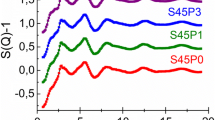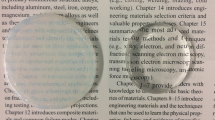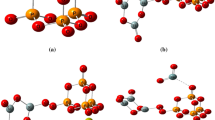Abstract
The suitability of Glass Polyalkenoate Cements (GPCs) for orthopaedic applications is retarded by the presence in the glass phase of aluminium, a neurotoxin. Unfortunately, the aluminium ion plays an integral role in the setting process of GPCs and its absence is likely to hinder cement formation. However, the authors have previously shown that aluminium-free GPCs may be formulated based on calcium zinc silicate glasses and these novel materials exhibit significant potential as hard tissue biomaterials. However there is no data available on the structure of these glasses. 29Si MAS-NMR, differential thermal analysis (DTA), X-ray diffraction (XRD), and network crosslink density (CLD) calculations were used to characterize the structure of five calcium zinc silicate glasses and relate glass structure to reactivity. The results indicate that glasses capable of forming Zn-GPCs are predominantly Q2/Q3 in structure with corresponding network crosslink densities greater than 2. The correlation of CLD and MAS-NMR results indicate the primary role of zinc in these simple glass networks is as a network modifier and not an intermediate oxide; this fact will allow for more refined glass compositions, with less reactive structures, to be formulated in the future.
Similar content being viewed by others
References
A. JOKSTAD and A. MJOR, J. Dent., 24 (1996) 309.
J. A. WILLIAMS and R. W. BILLINGTON, Journal of Oral Rehabilitation, 16 (1989) 475.
A. D. WILSON and J. W. NICHOLSON, “Acid-base cements, their biomedical and industrial applications.” (Cambridge University Press 1993.)
J. W. NICHOLSON, Biomaterials, 19 (1998) 485.
A. O. AKINMADE and J. W. NICHOLSON, J. Mat. Sci. Mat. Med., 4 (1993) 95.
S. G. GRIFFIN and R. G. HILL, Biomaterials, 20 (1999) 1579.
D. JULKA and K. D. GILL, Biochemica et Biophysica Acta., 1315 (1996) 47.
G. W. GUO and Y. X. LIANG, Brain Res., 888 (2001) 221.
L. GANDOLFI, M. P. STELLA, P. ZAMBENEDETTI and P. ZATTA, Biochemica et Biophysica Acta., 1406 (1998) 315.
P. ZATTA, Coordination chemistry, 228 (2002) 271.
W. F. FORBES, J. F. GENTLEMAN and C. J. MAXWELL, Experimental Gerontology., 30 (1995).(1) 23.
J. F. GENTLEMAN and W. F. FORBES, Experimental Gerontology, 33 (1998) 141.
S. POLIZZI, E. PIRA, M. FERRARA, B. MASSIMILIANO, A. PAPALEO, R. ALBERA and S. PALMI, NeuroToxicology, 23 (2002) 761.
C. V. SWEGERT, K. R. DAVE and S. S. KATYARE, Mechanism of aging and development, 112 (1999) 27.
C. EXLEY, J. Inorganic Biochemistry, 76 (1999) 133.
P. B. MOORE, J. A. EDWARDSON, I. N. FERRIER, G. A. TAYLOR, D. LETT, S. P. TYRER, J. PHILIP DAY, S. J. KING and J. S. LILLEY, Biol. Psychiatry, 41 (1997) 488.
G. BABIGHIAN, J. Laryngol. Otol, 106 (1992) 954.
E. ENGLEBRECHT, et al., J. Bone and Joint Surgery, 82-b (2000).(2) 192.
E. REUSCHE, P. PILZ, G. OBERASCHER, B. LINDNER, R. EGENSPERGER, K. GLOECKNER, E. TRINKA and B. IGLSEDER., Human Pathology, 32 (2001).(10) 1136.
M. DARLING and R. HILL, Biomaterials, 15/4 (1993) 299.
D. BOYD and M. R. TOWLER, J. Mat. Sci. Mat. Med., Accepted (2004).
M. YAMAGUCHI and T. MATSUI, Peptides, 17 (1996).(7) 1207.
J. OVESEN, B. MOLLER-MADSEN, J. S. THOMSEN, G. DANSCHER and L. MOSEKILDE., Bone, 29 (2001) (6) 565.
O. YAMAMOTO, Int. J. Inorganic Materials, 3 (2001) 643.
E. R. SEGNIT, J. Am. Ceran. Soc., 37 (1954).
A. SULLIVAN and R. G. HILL, J. Mat. Sci., 35 (2000) 1125.
International standard 9917:1991 (E). Dental Water Based Cements. International organization for Standardization, Case Postale 56, CH-1211, Geneve, Switzerland
J. HENRY, M. R. TOWLER, K. T. STANTON, X. QUEROL and N. MORENO, J. Chem. Tech & Biotech, 79 (2004) 540.
A. STAMBOULIS, R. G HILL and R. V. LAW, Journal of Non-Crystalline Solids, 333 (2004) 101.
I. ELGAYER, E. ALIEV, A. R. BOCCACCINI and R. G. HILL, J. Non Cryst. Solids (2004).Accepted.
G. ENGLEHARDT and D. MICHEL, “High-resolution solic state NMR of silicates and zeolites.” (John Wiley and sons 1987).
A. STAMBOULIS, R. V. LAW and R. G. HILL, Biomaterials, 25 (2004) 3907.
Author information
Authors and Affiliations
Corresponding author
Rights and permissions
About this article
Cite this article
Boyd, D., Towler, M.R., Law, R.V. et al. An investigation into the structure and reactivity of calcium-zinc-silicate ionomer glasses using MAS-NMR spectroscopy. J Mater Sci: Mater Med 17, 397–402 (2006). https://doi.org/10.1007/s10856-006-8465-x
Received:
Accepted:
Issue Date:
DOI: https://doi.org/10.1007/s10856-006-8465-x




